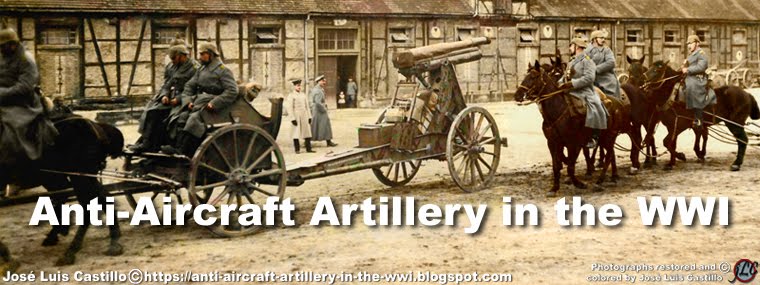Wednesday, September 21, 2022
US Navy Frayer-Miller trucks with Anti-Aircraft Guns type Driggs-Schroeder 1-pdr. Washington, D.C., 1919.
Friday, September 16, 2022
A Section of British Self-propelled Anti-Aircraft Artillery. Ludd, Palestine 1918.
Three British self-propelled guns belonging to a anti-aircraft Battery (4 guns). France, circa 1917.
French 75-mm L/35 Anti-Aircraft Gun. Châlons-sur-Marne, France. Circa 1916.
Wednesday, September 14, 2022
7.7-cm FK 96 n/A Flak ‘Schnetzler-Sockel' System M1916, of the Imperial German Navy.
7.7-cm FK 96 n/A Flak ‘Schnetzler-Sockel' System M1916, of the Imperial German Navy.
Three anti-aircraft guns belonging to a Battery of the German Imperial Navy. The platforms or mounts 'Schnetzler-Sockel' have been modified with obvious differences with the standard models, among others simplifying the lifting mechanisms of the pieces. Flanders, Belgium, probably in 1917.
*****************
7,7-cm FK 96 n/A Flak ‘Schnetzler-Sockel' Sistema M1916, de la Marina Imperial Alemana.
Tres cañones antiaéreos pertenecientes a una Batería de la Marina Imperial Alemana. Las plataformas o afustes 'Schnetzler-Sockel' han sido modificados con evidentes diferencias con los modelos estándar, entre otros simplificando los mecanismos de elevación de la piezas. Flandes, Bélgica, probablemente en 1917.
*****************
Posted by Jose Luis Castillo © 2022- Anti-Aircraft Artillery in the WWI
German Self-propelled Anti-Aircraft Gun of 7,62-cm L/30 K-Flak 17
German Self-Propelled Anti-Aircraft Gun Daimler-Krupp 7,7-cm L/27 K-Flak 14. - No.50
A German 7.7-cm Feldkanone 96 n/A (Field Gun), on a improvised anti-aircraft mount.
A German 7.7-cm 'Feldkanone' 96 n/A field gun, on a makeshift anti-aircraft mount. The cannon rests on a framework of thick wooden planks, firmly tied together with thick ropes. The assembly is capable of rotating 360º on a metal axis located above and in the center of a truncated concrete cone, which serves as the raised base of the anti-aircraft mount.
Note the two guides, possibly made of concrete, which were used to place the barrel on the concrete base, and also to remove the piece when it had to change its location.
********************
Un cañón alemán de campaña de 7,7-cm 'Feldkanone' 96 n/A, sobre un montaje antiaéreo improvisado. El cañón descansa sobre un entramado de gruesos tablones de madera, amarrado firmemente el conjunto con gruesas cuerdas. El montaje es capaz de girar 360º sobre un eje metálico situado arriba y en el centro de un cono truncado de hormigón, que sirve como base elevada del montaje antiaéreo.
Obsérvese las dos guías, posiblemente de hormigón, que servían para emplazar el cañón sobre la base de hormigón, y también para retirar la pieza cuando debía de cambiar de emplazamiento.
********************
Posted by Jose Luis Castillo © 2022- Anti-Aircraft Artillery in the WWI
Improvised Flak twin-wheel system for German 7.7 cm field gun.
Improvised Flak twin-wheel system for German 7.7 cm field gun.
One of the rarest German improvisations, adapted to anti-aircraft fire. Possibly inspired by the standard "Köbe-Protze" double wheel system. I have only found two photos of Flaks with double overlapping wheels. Both on the eastern front, including this one. The gun is the standard 7.7-cm field gun.
*********************
Sistema Flak de doble rueda improvisado para cañón de campaña alemán de 7,7 cm.
Una de las improvisaciones alemanas mas raras, adaptadas al tiro antiaéreo. Posiblemente inspirada en el sistema estándar "Köbe-Protze" de doble rueda. Sólo he encontrado dos fotos de Flaks con dobles ruedas superpuestas. Ambas en el frente del Este, incluida ésta. El cañón es el de campaña estándar de 7,7-cm.
Posted by Jose Luis Castillo © 2022- Anti-Aircraft Artillery in the WWI
Monday, September 5, 2022
A German old 9-cm C/73 Field Gun (M1873), adapted to the anti-aircraft fire (Flak).
Italian heavy machine gun 'Perino de 6,5-mm M1908', adapted for anti-aircraft fire.
Sunday, September 4, 2022
An Austro-Hungarian Anti-Aircraft Artillery Section deployed in the open field.
An Austro-Hungarian Anti-Aircraft Artillery Section deployed in the open field. It is composed of two 8-cm m.5/8 field guns adapted to anti-aircraft fire on a 360º rotating base, and whose height allowed a considerable angle to the pieces. The logs that can be seen around the Section were probably used to build blockhouses to protect the gunners from possible strafing by enemy aircraft.
The trunks that can be seen around the Section were probably used to build blockhouses to protect the artillerymen, totally exposed to possible strafing by enemy aircraft.
****************
Una Sección de Artillería Antiaérea Austro-Húngara desplegada en campo abierto. Esta compuesta por dos cañones de campaña de 8-cm m.5/8 adaptados al tiro antiaéreo sobre una base giratoria de 360º, y cuya altura permitía un ángulo considerable a las piezas.
Los troncos que se observan alrededor de la Sección, probablemente, se utilizasen para construir blocaos que protegieran a los artilleros de posibles ametrallamientos por parte de la aviación enemiga.
****************
Posted by Jose Luis Castillo © 2022- Anti-Aircraft Artillery in the WWI
Austro-Hungarian Laurin & Klement Anti-Aircraft Machine Gun Car. Italian Front, July 1917.
NOTE:
In my other blog 'Armored Cars in the WWI', I posted in March 2012,
that the same vehicle that appears in the photograph was a Benz. I
found out later that it was a Laurin & Klement. The
rest of the information is correct.
https://armoredcars-ww-one.blogspot.com/2012/03/austrian-benz-machine-gun-carrier.html
NOTA:
En mi otro blog ‘Armored Cars in the WWI’, publiqué en marzo de 2012, que el mismo vehículo que aparece en la fotografía era un Benz. Más adelante descubrí que se trataba de un Laurin & Klement. El resto de la información es correcta.
https://armoredcars-ww-one.blogspot.com/2012/03/austrian-benz-machine-gun-carrier.html
















